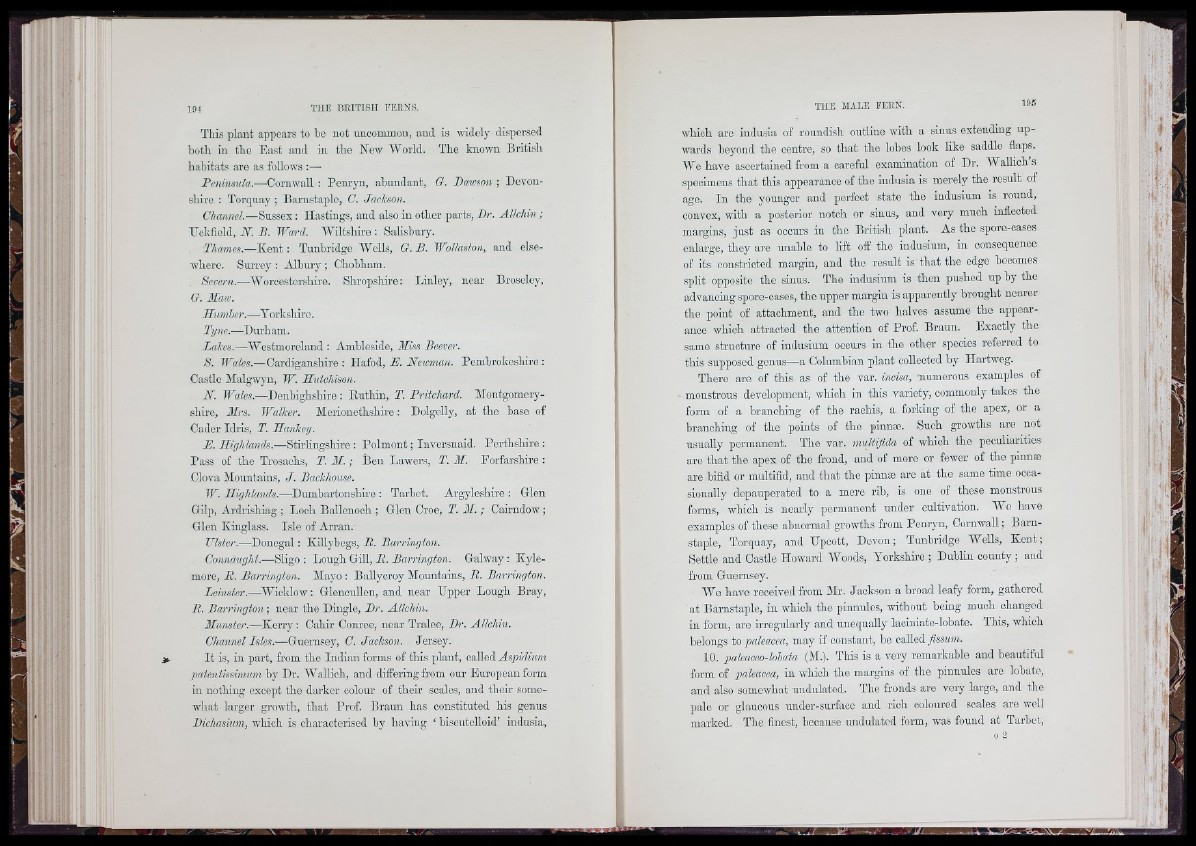
This plant appears to bo not nncoinmon, and is widely dispersed
both in tho East and in tho New IVorld. The known British
habitats arc as follows :—
Peninsuki.—Cornwall : Penryn, abundant, G. Bmcson ; Devonshire
: Torquay ; Barnstaple, C. Jackson.
Channel.—Sussex: Hastings, and also in other parts. Dr. Allchin ;
Hckficld, iV. B. Ward. IViltshlro : Salisbury.
Thames.—K e n t: Tunbridge Wells, G. B. Wollaston, and elsewhere.
Surrey : Albury ; Chobharn.
Severn.—^lYoroestersliirG. Shropshire: Linley, near Brosoley,
G. 2Ia,t'.
llumher.—Y orkshirc.
Ti/ne.—Durham.
Lakes.—IVestmoreland : Ambleside, 3Ii.ss Beever.
S. Trn/tfs.—Cardiganshire : Hafod, E. Newman. Pembrokeshire :
Castle Malgwyn, W. Hutchison.
N . Wales.—Denbighshire : Euthin, T. Pritchard. Montgomeryshire,
Sirs. Wilker. Merionethshire: Dolgelly, at the base of
Cader Idris, T. Hankey.
E. Highlands.—Stirlingshire : Po lm o n t; Inversnaid. Perthshire :
Pass of the Trosachs, T. M .; Ben Lawers, T. M. Forfarshiro :
Clova Mountains, J . Backhouse.
W. Highlands.—Dumbartonshire : Tarhct. Argyleshire : Glen
Gilp, Ardrishiag ; Looh Ballenooh ; Glen Croe, T. M . ; Cairndow ;
Glen Kinglass. Isle of Arran.
Ulster.—Donegal: KiUybegs, It. Barrington.
Connaught.—Shgo : Lough Gill, R. Barrington. Galway: Kyle-
more, R. Barrington. Mayo : Ballycroy Mountains, R . Barrington.
Leinster.—lYicklow: Glenoullen, and near Upper Lough Bray,
R. Barrington; near the Dingle, Br. Allchin.
Munster.—K e rry : Cahir Conroe, near Tralee, Br. Allchin.
Channel Isles.—Guernsey, C. Jackson. Jersey.
I t is, iu part, from the Indian forms of this plant, odAoii Aspidium
patentissimum hy Dr. Wallich, and differing from our European form
in nothing except the darker colour of their scales, and their somewhat
larger growth, that Prof. Braun has constituted his genus
Dichasium, which is characterised hy having ‘ hiscutolloid’ indusia.
which aro indusia of roundish outline with a sinus extending upwards
beyond the centre, so that the lobes look like saddle flaps.
We have ascertained from a careful examination of Dr. Wallioh s
specimens that this appearance of the indusia is merely the result of
age. In the younger and perfect state the indusium is round,
convex, with a posterior notch or sinus, and very much inflected
margins, just as ooours in the British plant. As the sporo-oases
enlarge, they are unable to lift off tho indusium, in consequence
of its constricted margin, and the result is that the edge bcoomos
split opposite the sinus. The indusium is then pushed up hy the
advancing spore-cases, the upper margin is apparently brought nearer
tho point of attachment, and the two halves assume the appearance
which attracted the attention of Prof. Braun. Exactly the
same structure of indusium ooours in the other species referred to
this su pposcd genus—a Columbian plant collected by Ilartweg.
There aro of this as of the var. incisa, numerous examples of
monstrous development, which in this variety, commonly takes the
form of a branching of the raohis, a forking of the apex, or a
branching of the points of the pinnæ. Such growths are not
usually permanent. The var. muUifida of which the peculiarities
are that tho apex of the frond, and of more or fewer of tho pinnæ
are bifid or multifid, and th a t the pinnæ are at the same time occasionally
depauperated to a more rib, is one of these monstrous
forms, which is nearly permanent under cultivation. lYo have
examples of these abnormal growths from Penryn, Cornwall ; Barnstaple,
Torquay, and Upcott, Devon; Tunbridge Wells, Kent;
Settle and Castle Howard lYoods, Yorkshire ; Dublin county ; and
from Guernsey.
Wo have received from Mr. Jackson a broad leafy form, gathered
at Barnstaple, in which tho pinnules, without being much changed
in form, are irregularly and unequally laciniate-lohate. This, which
belongs to paleacea, may if constant, bo called fissum.
10. palcaeeo-lobaia (M.). Tbis is a very remarkable and beautiful
form of paleacea, in which the margins of the pinnules aro lobate,
and also somewhat undulated. Tho fronds are very largo, and tho
pale or glaucous under-surface and rich coloured scales are well
marked. The finest, because undulated form, was found at Tarbet,